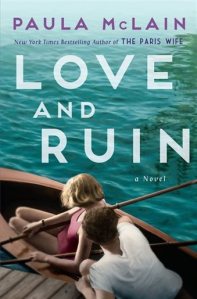Full disclosure: I received a copy of this book from Penguin Random House of Canada in exchange for an honest review.
In the early days of having a new baby, I wasn’t sure I would ever have the mental capacity to be able to read properly again. In the month after she was born, I finished two books. It was hard work and I’m not convinced I could tell you more about those books than “good.”
But then the days started to take some kind of regular shape and my brain started working a little again. Which is when I decided to read Paula McLain’s Love and Ruin.
I’m one of the only people (I think) that didn’t love The Paris Wife. I hated that the book was so much about Hemingway, rather than his wife who the book was supposed to be about. But then I really liked Circling the Sun about female aviator and all around sh*t disturber Beryl Markham. So even though Love and Ruin has to do with another of Hemingway’s wives, I decided that I did want to read it.

Martha Gellhorn is 28 when she travels to Spain, alone, in 1937 to cover the events of the Spanish Civil War. She lives in derelict hotel rooms trying to find her voice in the cacophony of male journalists reporting on what’s happening. She focuses on what the events mean to the people, the women and children in particular, who live in the affected areas.
And while her days are thus spoken for, her nights are spent with new friend Ernest Hemingway, the writer she most admires who she met back in Florida. Their friendship soon becomes something more and eventually, Martha becomes the third Mrs Hemingway. Ernest and Martha retreat to Cuba after the devastation they witnessed in Spain and spend months fixing up their little house there, a respite from the events unfolding in the world. But both are restless, each working on their next story.
When Martha finds journalistic success by writing about conflicts around the world, thus becoming more than just ‘Mrs Hemingway’, she must navigate the new realities of her marriage. Her husband isn’t used to sharing the limelight.
Love and Ruin reminded me of Z: A Novel. That book too was able to spotlight the wife of a famous man, to show the realities of living with such a talent and show Zelda’s story in her own right. Martha Gellhorn was herself a talented writer, a woman who reported on basically every major conflict over the SIXTY years of her career. Her marriage to Hemingway was a blip in her life, arguably one of the least interesting facets of her life and McLain is able to show that. Hemingway becomes a kind of footnote to Martha’s life, no small feat in my opinion.
I was hooked on this book immediately. The opening pages echoed sentiments that can be found today, of watching history happening and not being able to sit quietly by and watch.
It may be the luckiest and purest thing of all to see time sharpen to a single point. To feel the world rise up and shake you hard, insisting that you rise, too, somehow. Some way. That you come awake and stretch, painfully. That you change, completely and irrevocably – with whatever means are at your disposal – into the person you were always meant to be. […] There wasn’t any choice to be made, in the end. I would have to go to it, with my eyes wide open, and my hands open too, willing to pay the price.
I’m not sure that Love and Ruin will be found in too many people’s beach bags this summer (although it wouldn’t be the worst thing to read in the sun!) but I think people will find this one in the fall and feel like it was the perfect time to read it. Love and Ruin manages to balance the perceived frivolity of a love story with the gravity of current events. It was a powerful novel about finding one’s voice and vocation and I really enjoyed every page.
For once, I was sad to finish reading a book featuring Ernest Hemingway.
